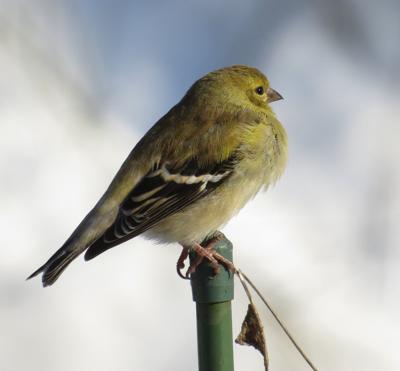©Marlene A. Condon
September 7, 2019

The American Goldfinches you see in late fall and early winter have greenish feathers, rather than the bright-yellow plumage of spring and summer that gives rise to the name, American (or Wild) Canary. Courtesy of Marlene A. Condon
The very first time I heard juvenile American Goldfinches, I didn’t recognize the sounds they were making. Employing binoculars, I located them in a tree, where they were begging their parents to be fed.
You can begin to hear their distinctive “crying” sound about the same time that Common Nighthawks are beginning to migrate south through our area, which is around the middle of August. However, it’s not unusual to first hear the young goldfinches as late as the middle of September.
Why would one bird species have young barely out of the nest at a time when other species are already leaving the area to escape the cold weather that’s coming? The answer is diet. Relying almost entirely upon fresh seeds to feed its young, these bright-yellow birds must wait until a numerous supply exists before reproducing, and that occurs in mid- to late summer.
Another reason for the delayed breeding time is the availability of thistle down (the fluffy filaments that help the seeds to be dispersed by the wind) that these little birds use to line their nests. Some species of thistles (Cirsium spp.) begin to bloom in June and have begun to go to seed by mid- to late July, allowing goldfinches to build their nests and to feed their chicks when they hatch.
Therefore, I love to see thistles growing on my property. People worry that these bristly plants can easily get out of hand and take over, but that is not true in a nature-friendly yard. Because goldfinches eat most of the seeds, very few are available to germinate the next year. I don’t have thistles every year, although I wish I did. The nectar-rich blooms bring in many kinds of butterflies, bees, and other kinds of insects.
Our native thistles are biennial plants that live only two years. The first year an attractive spiral of thorny leaves (a rosette) comes up. The following spring a flower stalk emerges from its center, the plant blooms and disperses its seeds, and then the thistle dies. It’s crucial that these thistles be available if goldfinches are to perpetuate their species.
The thistle most likely to be problematic for humans is the non-native Canada Thistle (Cirsium arvense). It’s perennial and spreads by underground stems (rhizomes) as well as by seed. Thus, it can be more difficult to completely eradicate from an area.
You can identify this plant easily by checking underneath the leaves and along the stalk for white hairs. Canada Thistle is “bare of hair” — my mnemonic poetic device for remembering how to recognize this non-native thistle. If you find a white “felt” of hairs, the plant is probably a biennial native that you should welcome to your yard.
During summer the pinkish-purple flowers of our native thistles will be covered with numerous butterflies and by fall the seed heads will bring in chirping, colorful, wild “canaries”. Now don’t you agree that a thistle or two in the garden is a great addition to the yard? I hope you do!
Marlene A. Condon is the author/photographer of “The Nature-friendly Garden: Creating a Backyard Haven for Plants, Wildlife, and People.” You can reach her at marlenecondon@aol.com and find info on marlenecondon.com.
